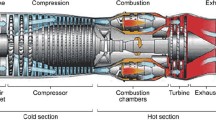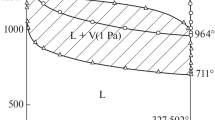Abstract
Volatilities and conversions of heavy metal compounds under oxidation conditions at elevated temperatures up to 1,000°C are analyzed using a thermogravimetric furnace to evaluate their behaviors in an incinerator. Most pure metals and their oxides are relatively stable without releasing metal substances into the atmosphere, except for several metals such as As and Hg. However, some chlorides are vaporized in the combustion temperatures and for these volatile chlorides, vaporization fluxes are obtained based on the measurement of their weight losses with increasing temperatures in the furnace. Experimental vaporization fluxes are compared to maximum theoretical fluxes from Herz-Knudsen’s kinetic theory of gas. Results of comparison show that evaporation coefficient, α, for each volatile heavy metal compound appears to be a characteristic value of the evaporating substance, not varying with increasing temperatures and the obtained coefficients are ranged in 10-6 to 108, which could be explained by a vaporization-condensation model of liquids. With some theoretical consideration on interfacial resistance, mass transfer coefficients, Kc for evaporation, are determined as a function of absolute temperatures, and ranged in 10-6 to 10-7.
Similar content being viewed by others
References
IAEA-TR-302, Treatment of Off-gas from Radioactive Waste Incinerators, IAEA, Vienna, 111 (1989).
EPA 520/1-91-010-1, Radiation and Mixed Waste Incineration Background Information Document, Vol. 1: Technology, 2-1-4-13(dy1991).
NUREG-1393, The Incineration of Low-level Radioactive Waste, U.S. NRC, 23 (1990).
Kim, J. H. et al.: Annual Report for “Development of Radioactive Waste Treatment Technology(III)Development of Radioactive Incineration Technology(IV)-Construction of Demonstration-Scale Incineration Plant”, KAERI-II/RR-9/90 (1991).
Kady, T., Trichon, M. and Feldman, J.: “Heavy Metals in the Stacks; Where are They?”, Proceedings of 1991 Incineration Conference, 597 (1991).
Caramelle, D., Horestan, J. and Waldura, C: “Incineration of Radioactive Waste: A System of Online Measurement of Gaseous Multicomponents”, ’90 Incineration Conference (1990).
Smith, W. S., Wong, T. and Williams, G.: “Incinerator Off-gas Monitoring”, Incineration Basic Course, Proceedings of ’89 Incineration Conference, (1989).
Trichon, M. and Feldman, J.: “Problem Associated with the Detection and Measurement of Arsenic in Incinerator Emissions”, Proceedings of ’91 Incineration Conference, 576-578 (1991).
Jacke. Fergusson, The heavy Elements; Chemistry, Environmental Impact and Health Effects, Pergamon Press, 92 (1989).
Goosens, W. R. A. at al.: “Treatment of Gaseous Effluents at Nuclear Facilities”, Harwoocl Academic Publishers, 311 (1990).
Caramelle, D. and Chevalier, G.: “Off-gas Cleaning and Release from Radioactive Waste Incinerator Protection and Safety Aspects”, Incineration of Radioactive Waste, Sep. London, (1985).
Feldman, J. and Trichon, M.: “Contribution of Metals Emissions from Radioactive Waste in Incinerators”, Lecture Notes for ’87 Incineration of Mixed and Low-level Waste Conference, Hl-Hll (1987).
Waterland, L. R. at al.: “Pilot-Scale Incinerability Evaluation of Arsenic and Lead-contaminated Solid from to Superfund Sites”, Proceedings of ’91 Incineration Conference, 335 (1991).
Krikorian, O. H.: “Analysis of Plutonium and Uranium Volatilities from Mixed Wastes in the Molten Salt Process”, Proceedings of ’91 Incineration Conference, 311 (1991).
Broomfield, B. J. and Fort, L. A.: “Assessment of High-temperature Thermal Processes to Treat Mixed Waste at the Hanford Site”, Proceedings of ’91 Incineration Conference, 571 (1991).
Waterland, L. R. at al.: “Trace Metals Fate in a Rotary Kiln Incinerator with an Ionizing Wet Scrubber”, Proceedings of ’90 Incineration Conference, 4.4.1-4.4.7 (1990).
Murray, F. et al.: “Metals, HCl and Particulate Removal using a Bag House, Crossflow Scrubber, and Ionizing Wet Scrubbers”, Proceedings of ’90 Incineration Conference, 5.5.0-5.5.9(1990).
Feldman, J. and Trichon, M.: “Contribution of Metals Emissions from Radioactive Waste in Incinerators”, Lecture Notes, ’87 Incineration of Mixed Waste Conference, H10-H20, (1987).
Bamford, C. H. and Tipper, C. F. H.: Comprehensive Chemical Kinetics, Elsevier Scientific Publishing Company, 3 (1975).
Kubaschewski, O. and Alcock, C. B.: Metallurgical Thermochemistry, 5th Edition, International Series on Material Science and Technology, 379 (1989).
Villa, H.:J. Soc. Chem. Ind., 59 (1950).
Richardson, F. D. and Jeffes, J. H. E.:J. Iron Steel Inst.,160, 261 (1948).
Weast, R. C.: CRC Handbook of Chemistry and Physics, CRC Press, Inc., Boca Raton, Florida.
Lamoreaux, R. H. and Hildenbrand, D. L.:J. Phys. and Chem.,13, 151 (1987).
Lamoreaux, R. H. and Hildenbrand, D. L.:J. Phys. and Chem. Ref. Data,3, 419 (1984).
Delany, L. J. and Eagleton, L. C.:AIChE J.,8, 418 (1962).
Sherwood, T. K. and Johannes, C:AIChE J.,8, 590 (1962).
Author information
Authors and Affiliations
Rights and permissions
About this article
Cite this article
Yang, HC., Seo, YC., Kim, JH. et al. Vaporization characteristics of heavy metal compounds at elevated temperatures. Korean J. Chem. Eng. 11, 232–238 (1994). https://doi.org/10.1007/BF02697389
Received:
Accepted:
Issue Date:
DOI: https://doi.org/10.1007/BF02697389




